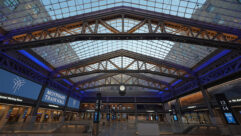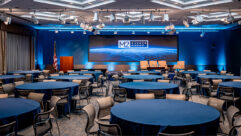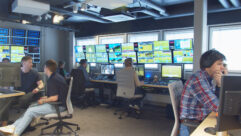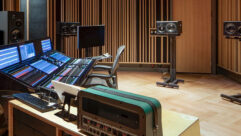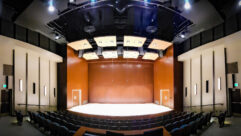
After a long winter nothing heralds a more welcome change of season than Radio City Music Hall’s all new theatrical production, New York Spring Spectacular starring the Rockettes along with Tony-award winning actress, Laura Benanti as the female lead Jenna and Emmy-award winning choreographer Derek Hough as the male lead Jack. Jointly produced by MSG Entertainment and Weinstein Live Entertainment and lead by an award winning creative team, New York Spring Spectacular takes audiences on a whirlwind adventure across New York City while telling an inspiring and hopeful narrative about New Yorkers who change each other’s lives in unexpectedly wonderful ways featuring invigorating new Rockettes dance numbers, incredible 3D special effects, sophisticated large-scale puppetry and an exciting soundtrack of original songs, classics and pop hits. The production also includes cameos from some of the biggest names in sports and entertainment including Whoopi Goldberg as the voice of the Statue of Liberty puppet, Bella Thorne as the voice of the Alice in Wonderland puppet and video cameos featuring Henrik Lundqvist, Carmelo Anthony, Kelly Ripa, Donald Trump and more. The production is running now through May 3, 2015.

A new show control system by Smart Monkeys, Inc. helps ensure that key elements of the New York Spring Spectacular run smoothly on Radio City’s famed Art Deco stage. The system also offers an expandable platform for future productions.
“Right from the start of our relationship with Smart Monkeys, it was clear that they had the depth and skill-set we needed to bring all the technical elements of the New York Spring Spectacular to life on stage,” said Larry Sedwick, senior vice president production, MSG Entertainment. “We are always focused on delivering our audiences with technology that has never been presented before in a theatrical setting. Smart Monkeys’ system and approach helped bring it all together on the great stage at Radio City Music Hall.”
The landmark theater had an aging sequencing show control system that needed modernization to keep up with today’s multimedia productions so video content producers Batwin & Robin put the venue in touch with Smart Monkeys, Inc. late last year. “Our expertise extends beyond theme parks and museums to include live staging,” notes Stephan Villet of Smart Monkeys, Inc. “The show control system we created for Radio City makes its debut with New York Spring Spectacular and can be used for future productions, too.”
Alan Anderson, designer and project manager for Smart Monkeys, Inc., says, “Our show control system moves Radio City Music Hall into the 21st century from a technical perspective without totally disrupting the workflow. The existing system was quite rigid. Now, we’ve introduced a much more flexible system that can be used to build much more complex, event-driven shows.”
“Broadway and Broadway-style theaters aren’t accustomed to using show control. But their productions have become too big not to use it,” adds Mitch Schuh, director of technology for Smart Monkeys, Inc.
Mission-Critical Performance
The challenge for Smart Monkeys, Inc. was to design a powerful and extremely reliable show control system that could perform a mission-critical role: It needed to act as a synchronizing agent for an array of elements for several shows a day in season. The system also had to feature a high level of redundancy, or failover, if problems occurred.
Since space is limited backstage in the historic theater Smart Monkeys, Inc. designed the show control system as two self-contained units, for redundancy, that can work independently or in tandem. Medialon Manager show control is at the core of the systems.
“The systems are in racks with wheels so they are mobile. Radio City can use them off site for rehearsals then migrate them back into the house for the shows,” Anderson explains. “We did exactly that with pre-techs in Pennsylvania for this show. We had a complete control system at our fingertips for rehearsals then packed it up and moved it into Radio City.”
Simultaneous with the introduction of a new show control system the venue upgraded its timecode sources. Instead of relying on audio-generated timecode, it has installed dedicated broadcast-grade timecode generators for scenic, lighting and some audio systems.
Driving Key Video and Audio Elements
Mitch Schuh programmed New York Spring Spectacular on the two show control systems running in parallel. “We’re one of the few companies that can reliably create a redundant system like this,” he says.
The system controls the main cluster and back up Delta 7th Sense playback servers that feed the video content to display surfaces.
“There are large LED surfaces along the back wall of the stage and halfway up the stage there’s a moving videowall that can split into six parts. We control the playback on these surfaces and trigger the timecode that the surfaces move on,” says Schuh. “We also control the video playback projected onto the ceiling of the hall over the audience.”
The show control system also makes sure that the main audio playback and back up systems are synchronized with video and dance elements at all times. Main audio playback consists of pre-recorded sound effects and a click track, which is heard only by the live orchestra.
Pre-recorded audio of the voice actors, who are not present on stage, and some additional sound effects reside on another audio system designed for “fast and agile on-demand cueing,” Schuh says. “They are all wild cues. The show control system gives the production the ability to have wild cues – something that wasn’t possible before when everything was locked to time.”
Schuh also controls timecode for systems not under his direct show control. “I trigger timecode onto independent timecode generators that distribute it to lighting and moving scenery,” he explains.
He handles system management chores from show control, too. “I do a lot of background system element checking to make sure that other systems are online and redundancy is in effect and to show other operators the status of their systems,” he says. Schuh monitors his own systems as well, including battery back ups on his servers.
Easy Operator Interface
Schuh created the interface design for operators ensuring that they had “exactly what they need – not more, not less” for Radio City’s shows and other live events at the venue.
“Operators have independent Windows 8 computers with touchscreens, which fit next to their control consoles,” he explains. “They also have a DNF Controls button panel with LED colors and text for a traditional tactile way of advancing cues. The touchscreen has the cue list, the status commands, stop and go buttons. These are mirrored with the physical button panel. So operators can choose the way they prefer to work. They can run cues off the primary or secondary system at all times.”
Schuh points out that the show control system is expandable and can take on more aspects of a show in future. “It gives Radio City the creative freedom to expand their ideas knowing that show control can take over more roles as the creative dictates,” he says. “We believe that now the tools are available to them, they will use more and more of them in upcoming productions.”
About Smart Monkeys
Smart Monkeys, Inc. specializes in providing advice, project management and programming for show control offering a reliable, high-quality alternative to inhouse resources for project-based consulting, control systems development and project specific system programming. For more information, visit www.smart-monkeys.com.
# # #


